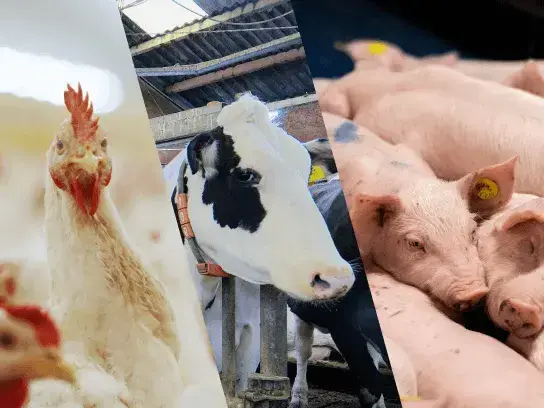- Cattle
- Dairy cattle
- 2 minutes read
For dairy cattle farm managers, increasing milk production is essential for the success of their farm. While management practices such as proper nutrition and health management play a crucial role, lighting can significantly impact milk production as well. Our team recently conducted a in-depth research to support these words with numbers.
In this blog, we'll discuss by how much RUDAX lighting and a HATO light scheme naturally improve milk production of dairy cows according to our research.
The research
We've tested the RUDAX lighting solution in a research farm in China where we saw milk production improvements of 8%. To confirm these findings in a country with higher production numbers, our team conducted a two-year research study at a Dutch dairy farm with 100 cows, of which 85 in production.

Before situation
During the before situation, the farm used sodium lighting, with an average light intensity of 50 lux in the resting area and 70 lux in the feeding area. The lights didn't have sensors to regulate the light intensities, nor did they have dimming possibilities. The lights were on 24/7.
After situation
We installed 39 RUDAX led lighting solutions, which provided an average light intensity of 180 lux in the resting area and 120 lux in the feeding area. The RUDAX lighting had a CRI (Colour Rendering Index) of 83 with an average colour temperature of 4600K. A light sensor regulated the light intensity, and the RUDAX enabled 100-0% dimming. We used a HATO light scheme, using different colours to realise the best results.
Curious about the composition of the light scheme? Learn more by downloading our research paper.

Increased milk production
The 305-day production was taken into account, and the results showed that replacing sodium lights with RUDAX lighting and using the HATO light scheme naturally increased milk production. In the comparison group, the average increase was significant with +5.8 Kg per day (+17,5%). Since management changes and lactation numbers outside the target group also contributed to the increase in milk production, an estimated 20%-40% of the increase was caused by lighting.
This means that in the comparison group an estimated milk increase per cow of 1.2 – 2.3 Kg or 3.5% – 14% a day was realised only by the replacing of sodium lights by RUDAX lighting and using the HATO light scheme. As you can imagine, this had a significant impact on profits as well.
More detailed information about the increase in milk production per lactation group and the increase in profits? Download our research paper today!
Stay informed
Lighting matters. That's why we share our knowledge with the world through HATO Insights.
Cattle
How RUDAX LED Systems Deliver Measurable Supply Chain Gains
As global demand for dairy continues to rise, milk processors are under pressure to ensure consistent, high-volume, and high-quality milk supply. On-farm...
Cattle
Case Study: Validating the Impact of RUDAX Lighting on Dairy Cow Milk Production
Precision Lighting Shows Measurable Gains in Yield and Quality of Milk Lighting remains one of the most overlooked yet high-impact levers in dairy production....
At HATO, we think high-quality lighting solutions, designed to enhance animal welfare and livestock production, must be accessible and affordable for all farmers.
Success Stories
Five Years, Zero Replacements: Why CORAX Is George Navaro’s Lighting of Choice
Herman Kusters: I would definitely recommend RUDAX

.webp)
.webp)